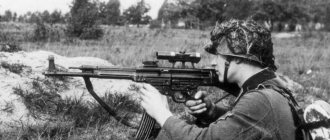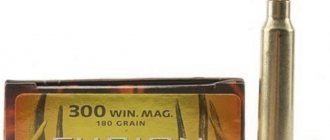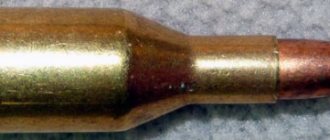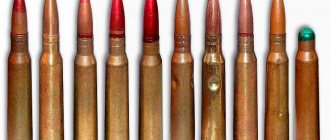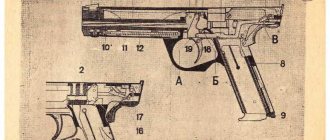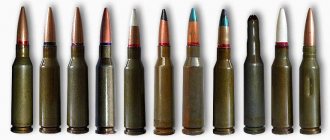"3030" redirects here. For the publishing company, see 3030 Press. For the adventure game, see 3030 Deathwar.
| .30-30 Winchester | |||
| 5.56×45mm NATO (left), .30-30 cartridge (center) and 7.62×51mm NATO (right) | |||
| Type | Rifle | ||
| Place of origin | United States | ||
| Production history | |||
| Designer | Winchester | ||
| Developed | 1895 | ||
| Manufacturer | Winchester | ||
| Produced | 1895–present | ||
| Options | .25-35 Winchester, .219 Zipper, .30-30 Ackley Improved, 7-30 Waters, .32 Winchester Special | ||
| Characteristics | |||
| Parent case | .38-55 Winchester | ||
| Type of shell | Rim, bottleneck | ||
| Bullet diameter | .308 in (7.8 mm) | ||
| Neck diameter | 0.330 in (8.4 mm) | ||
| Shoulder diameter | 0.401 in (10.2 mm) | ||
| Base diameter | 0.422 in (10.7 mm) | ||
| Rim diameter | 0.506 in (12.9 mm) | ||
| Rim thickness | 0.063 in (1.6 mm) | ||
| Case length | 2.039 in (51.8 mm) | ||
| Full Length | 2.550 inches (64.8 mm) | ||
| Primer type | big rifle | ||
| Maximum pressure (SAAMI) | 42,000 psi Inch (290 MPa) | ||
| Ballistic characteristics | |||
| 1760 ft⋅lbf (2390 J) | |||
| 130 g (8 g) FP | 2,496 ft/s (761 m/s) | 1799 ft⋅lbf (2439 J) | |
| 150 g (10 g) FN | 2,390 ft/s (730 m/s) | 1,903 ft⋅lbf (2,580 J) | |
| 160g (10g) cast LFN | 2,330 ft/s (710 m/s) | 1929 ft⋅lbf (2615 J) | |
| 170 g (11 g) FP | 2,227 ft/s (679 m/s) | 1873 ft⋅lbf (2539 J) | |
.30-30 Winchester
/.30
Winchester center fire
cartridge was first marketed in 1895 for the Winchester Model 1894 lever action rifle.
[2] The .30-30 ( thirty-thirty
), as it is most commonly known, and the 25-35 were offered that year as the first small-bore sporting rifle cartridges chambered for smokeless powder in the United States. Sixty years after its introduction, in 1955, it was surpassed by the smaller caliber .243 Winchester cartridge with more powerful and accurate ballistics but similar recoil, but the .30–30 Winchester remains widely used even today. [3]
Naming[edit]
+0.30 Winchester smokeless
first appeared in Winchester catalog No. 55, dated August 1895. When chambered in the Winchester Model 1894 carbine and rifle, it was also known as
the .30 Winchester center fire
or
.30 WCF
.
When the cartridge was chambered in the Marlin Model 1893 rifle, rival gunmaker Marlin
used the designation
.30-30
or
.30-30 Smokeless
.
The added value of -30
corresponds to a standard 30 grain (1.9) loading of early smokeless powder and is based on late 19th century American black powder cartridge naming conventions. Both Marlin and Union Metallic Cartridge Co. also abandoned the Winchester name, as they did not want to put the name of competitor Winchester on their products. [4]
The modern .30-30 Winchester designation was derived by using a variation of the Marlin name with the Winchester name added as the source of the cartridge, but the .30 WCF
still occurs occasionally.
This designation also likely helps avoid consumer confusion with the other but similar-shaped .30-40 Krag, which were designated .30 US
and
.30 Army
.
Price
- For the Marlin 336 BL model, the manufacturer has set a minimum recommended price of $667. The same money will cost you, for example, a rifled Vepr-Hunter, Saiga MK 03 sp.
- Model 336Y, in his opinion, cannot cost less than 548 (about the same as MP-155), and 336XLR - $969 (like Sabatti Rover, Zastava m70).
Marlin 336 with Henry brace
Characteristics and use[edit]
Originally produced by Winchester Repeating Arms (WRA) and Union Metallic Cartridge Company (UMC), it was manufactured with a 160gr metal patch (jacketed) lead bullet. A year later, UMC released a 170 grain bullet. Both 150- and 170-grain bullets continue to be very popular, as evidenced by the number of these weights offered by current manufacturers. However, the 160 grain bullet weight has reappeared in modern cartridges from Hornady, as noted below. Jacketed bullets for the .30-30 have a nominal diameter of .308 inches. Cast lead bullets for the .30-30 are also popular and typically measure 0.309 inches in diameter.
The .30-30 is considered the "entry class" for modern big game hunting cartridges, and when describing their trajectory, it is common to define the performance of cartridges with similar ballistics as the ".30-30 class". . Although it is very effective on game as large as deer and black bear, most commercial ammunition for this purpose is limited in effective range to approximately 200 yards (183 m), unless using ballistic-tipped ammunition. The cartridge is typically loaded with 150 to 170 grain (9.7–11.0 g) bullets, but lighter cartridges are possible. Bullets up to 180 gr (11.7 g) can be used, but the overall length of the lever action rifles most commonly used for this cartridge limits their usefulness.
In Canada and the United States, the cartridge has also been used on moose, caribou and pronghorn. Current opinions in Canada about its suitability for moose are mixed. Paul Robertson, a Canadian firearms reviewer, says, "Too many elk have been taken with [.30-30] to rule it out as being suitable for this purpose as well." [5] In both Canada and the United States it has long been used on moose. [6] It is generally accepted that the .30-30 is not the best choice for hunters who want to shoot animals at long ranges. A cartridge with flat or round nose bullets does not meet the minimum energy standards required for moose hunting in Finland, Norway or Sweden. [7]The choice of cartridge is determined by hunting technique and style, as well as law and culture. [8] Thor Strimbold, a Canadian who has killed more than 20 elk with one shot with a .30-30 rifle, advises most elk hunters to use more than the minimum power if they can handle the recoil. [9] Although the .30-30 is legal for moose hunting in Newfoundland, Canada, provincial authorities do not recommend its use. [10]
One of the main reasons the .30-30 is popular among deer hunters is its low recoil. Average recoil from a typical 150 grain load at 2,390 feet per second (730 m/s) in a 7.5 lb (3.4 kg) rifle is 10.6 ft lb (14.4 J) of felt recoil at the shooter's shoulder. which is about half that of the shooter. a similar rifle chambered in .30-06 Springfield. [11] However, the .243 Winchester offers greater muzzle energy and much greater terminal energy in low field than the .30-30 with the same light recoil. [3]
Since most rifles chambered for the .30-30 cartridge are lever-action rifles with tubular magazines, most .30-30 cartridges are loaded with round or flat nose bullets for safety. This is to prevent a sharp-tipped bullet (the shape shown on the 7.62×51mm NATO above) from firing the cartridge primer in front of it in the magazine during recoil, which would cause potentially catastrophic damage to both the firearm and the shooter . The Savage Model 99 was introduced in 1899 with a rotary magazine, in part, to avoid this problem. When used in single-shot rifles or pistols such as the Thompson Center Arms Contender or Encore series, shooters typically handload the coil-tip bullet cartridge for improved ballistics.
A notable exception to the "pointless bullet" rule for choosing bullets for rifles with tubular magazines is the new LEVERevolution "memory elastomer" tipped flex cartridges made by Hornady. [12] The soft tips of these bullets easily deform under compression, preventing detonation from magazine recoil, but also return to their original pointed shape when that pressure is released, allowing for a more efficient bullet shape than previously available for loading. safe in such rifles. The more aerodynamic shape results in a flatter bullet trajectory and greater residual velocity down the range, greatly increasing the effective range of rifles chambered for this cartridge. [13][14]
Disassembly
To clean the weapon, simply remove the bolt. Further disassembly outside of a gunsmith shop is not recommended.
- Unload the weapon by lowering and raising Henry's brace several times. Make sure that the chamber is clean and there is nothing in the magazine - when the magazine shutter is recessed, the red cartridge pusher is visible.
- Lower the bracket, open the bolt. Unscrew the screw securing it to the hinge bracket on the receiver.
- Remove the bracket.
- Press the trigger lever and remove the bolt.
- Remove the cartridge deflector spring from the receiver. It is better to use tweezers for this.
Rifles and pistols chambered for .30-30[edit]
.30 WCF ammunition
The .30-30 is by far the most common cartridge in lever action rifles [15] such as the Winchester Model 1894 and Marlin Model 336. Some earlier Savage Model 99 rifles were also chambered for this cartridge. More recently, Mossberg has released lever-action rifles, the Mossberg Model 472, 479, and the newer Model 464. You can also find these Mossberg rifles under the Western Field brand (sold through Montgomery Ward as the M72). The 472 was only produced from 1970 to 1979, and the 479 until 1983 - both are rare and often confused with the Marlin 336 due to their similar appearance. The Roy Rogers Edition features a gold trigger and buttplate, and the stock is signed by Roy Rogers. Rossi of Brazil recently began offering what is essentially a clone of the Marlin 336 series in .30-30 caliber. Winchester produced a simplified and more fuel-efficient version of its popular '94 model through Sears under the Ted Williams name and through Western Auto under the Revelation label.
The rimmed design lends itself well to a variety of solo activities, so it is also commonly found there. Edging cartridges are chambered bolt action rifles, but 30-30 bolt actions are rare today. “At one time, Winchester released the Model 54 bolt-action repeater in this caliber [.30 WCF], but it was a decisive failure, mainly because the person who wanted to operate the bolt chose to take one of the better and more powerful cartridges . However, the .30 WCF cartridge in this particular caliber has proven to be completely accurate." [16] Additionally, rimmed cartridges generally do not work well with the box magazines typically used in bolt-action rifles. [17] [18] Other examples of bolt-action rifles offered in .30-30 Winchester are the Stevens Model 325, Savage Model 340, Springfield/Savage 840, and Remington 788.
In metallic silhouette pistol sport shooting, the .30-30 was used. The Thompson Center Arms Contender pistol, with its compact frame and intermittent action design, is available in .30-30. The .30-30 will achieve nearly 2,000 f/s (610 m/s) out of the Contender's 10-inch (25 cm) barrel, although recoil and muzzle blast are greater due to the short barrel. A longer barrel results in significantly reduced felt recoil (due to increased weight) and muzzle blast at higher velocities, especially if factory ammunition is used. Magnum Research offers a five-shot BFR revolver in .30-30 caliber. [19]
Design
Rifled carbine reloaded with a Henry clip (Lever action). The magazine is tubular, under-barrel.
- The barrel is made of stainless steel, cold forged, with a dozen small rifling (Micro-Groove® rifling barrel), allowing the use of soft non-jacketed, as well as polymer film-coated bullets.
- The bolt is longitudinally sliding, locking occurs by engaging two vertical pins into the recesses on the stem. There is only one extractor tooth, the bolt cylinder has no edges.
- The receiver is made of stamped steel. The cartridge ejector window is located on the right side. Below it is the window of the store bunker, closed with a spring-loaded curtain.
- On the upper edge of the receiver, there are optionally four threaded holes or two recesses, forming a kind of dovetail strip. They are used to mount optical sights.
- The Henry brace is made of steel and extends almost to the end of the bottom edge of the pistol grip of the stock.
- The trigger mechanism has an external cocking lever, so it is not equipped with the usual safety box. The weapon is deactivated as follows: slightly press the trigger shank down with your thumb, thereby freeing the mainspring from the sear hook, and then allow it to return forward, while keeping it from hitting the firing pin sharply.
- A set of external sighting devices consists of a simple rear sight, vertically adjustable, and a fixed front sight, covered with a round casing.
- The stock is semi-pistol, with a flat handle. It and the fore-end have well-developed corrugation, which improves grip reliability. Buttstock with shock-absorbing butt plate. The ridge is straight, with a slight inclination to the axis of the trunk.
Spare parts for the Marlin 336 shotgun
Derived cartridges[edit]
In addition to the most common factory variants such as the .25-35 Winchester, 6.5x52mmR, .32 Winchester Special and the lesser known .219 Zipper, the .30-30 has also spawned many wildcat cartridges over the years. One example is the 7-30 Waters cartridge, made by narrowing a .30-30 case to 7 mm (0.284 in) thick. The 7-30 Waters eventually transitioned from a wildcat design to a factory cartridge, with rifles made by Winchester and barrels made by Thompson/Center for their Contender pistol. Other .30-30 based wildcats are used almost exclusively in Contender pistols. One of the most notable examples is the .30 Herrett., the .30-30 case is bent back to reduce case capacity for more efficient loading of fast-burning powders. The .30 Herrett produces higher velocities with less powder than the larger .30-30 case with the short 10- and 14-inch (25- and 35-cm) Contender barrels. Other examples are the .357 Herrett, designed to shoot heavier bullets and larger game than the .30 Herrett, and the 7mm International Rimmed, a popular metallic silhouette cartridge. Bullberry, a manufacturer of custom Contender barrels, offers proprietary .30-30 wildcats in 6mm, 0.25 and 6.5mm diameters. [20] [21] Additionally, Ackley software used the cartridge as the basis for the .30-30 Ackley Improved.
Perhaps the oldest derivative cartridge is the Wildcat 35-30 cartridge, also known as the 35-30-30, 35/30-30, and 35/30. This cartridge was never produced at the factory. Rather, it was an invention to counteract the corrosion of the first 30-30 barrels due to the use of black powder and shotguns. The barrels, no longer in use, were bored out to .35 caliber and the .30-30 case was re-strung and loaded with a .35 caliber bullet. [ citation needed
]
Links[edit]
- » .30-30 loading data. Archived November 16, 2007 on WebCite" from Hodgdon.
- Data "Load Guide" from Accurate Powder.
- ^ ab Ron Spomer. » Whitetail Deer Cartridge Shoot-Out: .30-30 Win. Against .243 Win. Against the .30-06 Springfield." Outdoor Life
, October 28, 2022. Accessed March 4, 2022. - Leverguns.com article on .30-30 history.
- ↑
"Immortal 30-30",
Western Sportsman,
October, November 1990 - ↑
Bert Stent, "Small Miracle - 30-30 Carbine",
British Columbia,
July 1988;
Bob Milek: "The old .30-30 is as good as ever!" Weapons and Ammunition
July 1985;
Gritz Gresham, " 30/30
",
Sports,
August 1989. - LEVERevolution's 160-gr flex Spitzer-tipped Hornady ammo can complicate matters. Based on the results of the Real Guns
(reviewguns.com), the remaining charge energy in the tested carbine can hold more than 2,000 joules at 100 yards, which is close to what is required at 100 m in Finland and Sweden (2,200 in Norway). - Bob Milek, "What Determines" Maximum Effective Range "?" Guns & Ammo,
December 1989 - ↑
H.V. Stent, "The Winchester Model 94",
Gun Digest
1980. - Newfoundland Hunting Regulations.
- Article » Chuck Hawks » IDEAL DEER CARTRIDGES.
- » LEVERevolution archived 2006-11-14 in the Wayback Machine » on the Hornady website.
- Hornady LEVERevolution Gun ammo and shooting games online Staff on Chuck Hawks.
- Mann, Richard. ".30-30 rides again". Weapons and hunting
. National Rifle Association. Archived from the original on February 6, 2007. - Chuck Hawks article Deer Rifle
- Sharp, Philip B. (1937). "Rifle loading data, part two." The Complete Guide to Hand Loading, A Treatise on Hand Loading for Fun, Economy, and Usefulness
. Funk & Wagnalls. paragraph 368. - “Rim cartridges have certain disadvantages, but they were not a concern at the time the design was introduced. The biggest one is the difficulty of ensuring reliable feeding from a box magazine. The rims tend to interfere with each other during the feed cycle. This occurs when the rim of the cartridge tries to separate the cartridge underneath, as the rims do not ride over each other easily.” in The Cartridge case Archived October 19, 2022 article Wayback Machine by Sierra Bullets.
- “When you stack multiple rounds in a magazine, the rims get in the way.” in WEAPONS AND AMMUNITION: Terminology - Firearms.
- BFR article archived 2006-10-14 in the Wayback Machine on the Magnum Research website.
- "Cartridge is loading". Hojong. Archived from the original on 2007-11-16. Retrieved August 1, 2007., .30 Herrett, 130 gr at 2344 ft/s with 22 gr H110; .30-30 pistol, 130 gr at 2,238 ft/s with 36 gr Varget
- Bulleberry Barrel Factory. "Bullberry Load Data". Archived from the original on 2008-10-15. Retrieved October 13, 2008.
Operating principle
When the Henry brace is pushed down, two vertical pins in the receiver slots move out of mate with the bolt cylinder. With further movement of the lever, the bolt is retracted, the spent cartridge case or cartridge is removed from the chamber and thrown out by the reflector through the receiver window. The buttplate of the bolt extends outward from the receiver, hooks onto the cocking lever and pulls it back, bringing the firing mechanism into the firing position.
- At the same moment, the cartridge is fed from the magazine into the hopper. It is raised onto the loading line by the elevator when the bolt moves back, when the Henry bracket returns to its place. After the bolt cylinder enters the breech, the locking pins rise up and hold it.
- To load the rifle, turn it with the magazine hopper window facing up. The cartridges are placed with the bullet forward, overcoming the resistance of the hopper curtain spring, which has a semicircular recess for the convenience of the process.
Before the shot, Henry's brace is energetically lowered and just as energetically returned to its place. The bolt stem extends out of the receiver almost the entire length, so it is better to hold the stock with the butt down, suspended.
- The bolt will move the trigger lever and place it horizontally. If you do not need to fire immediately, press the lever with your thumb to release it from engagement with the sear, then, keeping it from striking the firing pin, return it to the vertical position.
